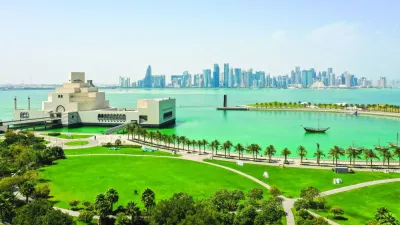Apart from the hearty heaps of authentic food and a delightful dose of culture that the ongoing Vietnamese Culture and Cuisine Festival has put on offer at Sridan restaurant at Shangri-La Hotel Doha, there’s also a fascinating glimpse into Vietnam tourism through vivid photographs and detailed summaries of must-visit Vietnamese heritage sites, put together by the Vietnamese embassy.
Nguyen Hoang, the ambassador of Vietnam to Qatar, told Community, “This is the first time that we have organised such an event in Doha, focussing on our culture and cuisine. These photographs and summaries of world heritage sites in Vietnam help familiarise the wide range of tourism options to the visitors of this festival.” Here’s a quick run through five of these heritage sites with details sourced via Vietnam Tourism.
Ha Long Bay
This natural heritage site is situated in the north-east region of Vietnam. Ha Long Bay is a part of Bac Bo Gulf and comprises the sea area of Ha Long city, Cam Pha city and a part of Van Don island district, Quang Ninh province. It borders Cat Ba Island to the south-west, the mainland to the west with a 120km-long coastline. Ha Long Bay covers a total area of 1,553 sq km, including 1,969 islands of various sizes, 989 of which have been given names. There are two kinds, limestone and schist, which are concentrated in two main zones: the south-east (belonging to Bai Tu Long Bay) and the south-west (belonging to Ha Long Bay). The average geological age of the islands is between 250 and 280 million years old. Ha Long Bay has been called by the great national poet Nguyen Trai: “A marvel of the earth erected towards the high skies.” While exploring the bay, tourists will feel lost in a legendary world of stone islands which shapes change depending on the angle and the light.
Phong Nha-Ke Bang National Park
This natural heritage lies in Quang Binh province – the central Vietnam. Covering an area of more than 343,000 hectares, Phong Nha-Ke Bang situated in Quang Ninh, Bo Trach and Minh Hoa districts, is 50 km northwest of Dong Hoi city. Phong Nha-Ke Bang can be compared to a huge geological museum thanks to its complicated geological structure with different categories of stone including sandstone, quartz, schist, siliceous limestone, granite, granodiorite, diorite, applet, pegmatite, etc. Phong Nha-Ke Bang is the oldest and largest tropical karst formed 400 million years during the main geological periods of the Earth, bearing the original topographic and geologic characteristics. Experiencing major tectonic phases, high mountain ranges and the depressed sedimentary basins were formed. These fluctuations have also contributed to the diversity of geology, topography, geomorphology. Phong Nha-Ke Bang karst mountains can provide a lot of valuable information about the Earth’s prolonged geological process through various periods, from the Ordovician Age and Silurian Age (about 463.9 - 430 million years ago) to the Quaternary Age (1.75 million years ago).
Citadel of the Ho Dynasty
This world cultural heritage site was the capital of Vietnam from 1398 to 1407. The citadel of the Ho Dynasty was built in 1397 by Ho Quy Ly who was the highest-ranking mandarin of the Tran Dynasty at the time. After the citadel was completed, Ho Quy Ly forced King Tran Thuan Tong to move the capital from the citadel of Thang Long (Ha Noi) to Thanh Hoa. In the second month of the year of Dragon (1400), after coming to the crown to replace the King Tran, Ho Quy Ly renamed the country Dai Ngu (1400-1407), the citadel of the Ho Dynasty officially became the capital citadel. The citadel of the Ho Dynasty is also known by the names of An Ton, Tay Do, Tay Kinh, Tay Nhai,Tay Giai. The citadel of the Ho Dynasty is considered as the only stone citadel remaining in Southeast Asia and is one of the few remains in the world.
Complex of Hue Monuments
Complex of Hue Monuments lies along the Perfume River in Hue city and some adjacent areas of Thua Thien Hue province. Hue city constitutes the cultural, political and economic centre of the province, and was the old imperial city of Viet Nam under the Nguyen Dynasty from 1802 to 1945.
My Son Sanctuary
My Son Sanctuary is set in a small valley belonging to Duy Phu Commune, Duy Xuyen district, Quang Nam province, about 70km southwest of Danang city and 40km from Hoi An city. Of the 225 Cham vestiges that are founded in Viet Nam, My Son possesses 71 monuments and 32 epitaphs, the content of which is still being studied.

Ha Long Bay


